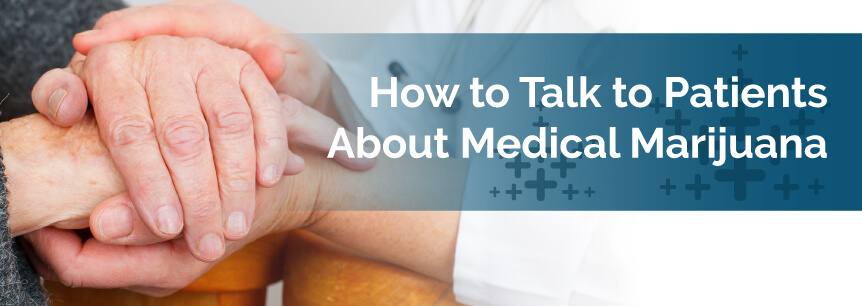
Though government bodies and officials are becoming more open-minded about legalizing medical marijuana, we already know people have been using it for years, both recreationally and for medicinal reasons. However, what’s interesting is how cannabis has changed culturally over the years. What people once thought of as taboo is now sitting right on our kitchen table.
Honestly, though, it’s a sensitive matter having to approach your patients and ask them if they use marijuana or want to use it to help deal with their symptoms of a medical condition. The same holds true if they bring the topic up to you in a patient consultation. It can be an uncomfortable conversation to have, since the legalization and use of medical marijuana are still, in many ways, in their infancy.
However, as more and more states legalize cannabis for its use for medicinal purposes, talking to patients about marijuana will get easier. This guide on talking to your patients about medical marijuana is intended to help you, as their physician, make these types of conversations about cannabis smooth and straightforward.
It’s essential to realize talking about cannabis with your patients isn’t illegal. In fact, you’re legally obligated to keep your patient conversations confidential. You can tell your patient this too, so they’ll know it’s safe to be honest and open with you about medical weed, what they’re looking to achieve with it and why they think it will help them.
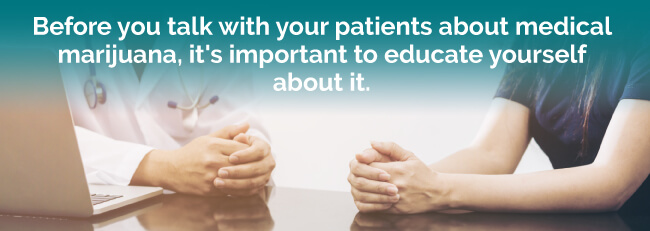
Before you talk with your patients about this herb, it’s important to educate yourself about it.
When broaching the subject of marijuana, you should:
Other things to take into consideration when talking about marijuana with your patients include:
Don’t be skittish or embarrassed, or let your patients feel that way. Encourage them to provide accurate information about their weed use. Remind them medical marijuana is legal in more than half of U.S. states, and that being frank with you about what they’re putting into their body is certainly allowed — and encouraged. Though they may feel uncomfortable with this conversation, encourage your patients to be direct and clear with you.
Be a good advocate for your patient, too. Ask them to share how cannabis affects both their physical and mental health. Obtain a detailed list of the medications they’re currently taking, and any side effects associated with them. Ask them how medical marijuana eases their symptoms and side effects.
Depending on the other medicines your patient is taking, marijuana could have some side effects. Discuss these side effects with your patient. If you’re not up to date on endocannabinoid science, conduct research yourself so you can talk about it with your patient confidently and knowledgeably.
Ask your patient about their particular condition and if they’re trying to medicate with cannabis. Different conditions qualify for medical marijuana in various states. For instance, some states allow medical marijuana to treat post-traumatic stress disorder, while other states don’t. Again, educate yourself on this information so you can guide patients in the right direction.
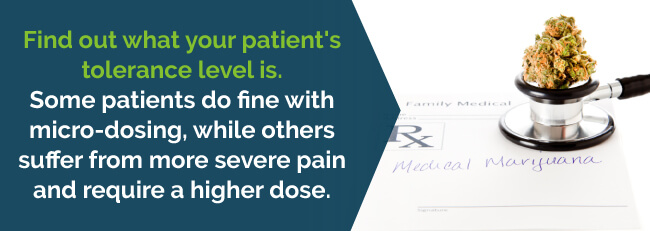
Find out what your patient’s tolerance level is. Some patients do fine with micro-dosing, while others suffer from more severe pain and require a higher dose.
If you’re like many doctors, you may want to steer your patient away from smoking medical cannabis and encourage them to use other marijuana consumption methods instead, like:
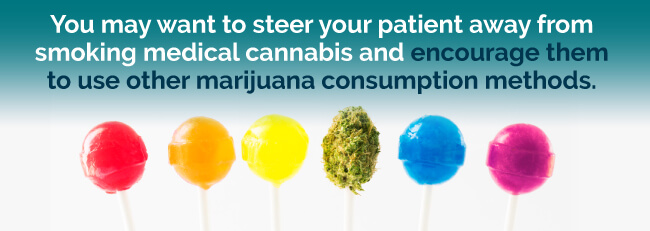
These are all good options if your patient prefers not to smoke their medical cannabis. For other patients, however, smoking provides them with quick pain relief when their disease symptoms become too unbearable.
Talk with your patients about when they typically medicate. For some people, marijuana is not a suitable daytime treatment because it may make them drowsy. In this case, they’d be better off dosing at night. That said, some marijuana strains, like Indica, are better suited for taking at night — and some, such as Sativa strains, are more appropriate for daytime use.
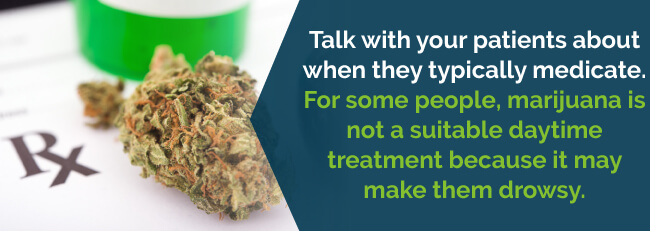
Here’s a list of things to go over with your patient to determine if they’re a good candidate for medical marijuana:
The more details you get from your patients, the better you’ll be able to treat them. You especially want them to discuss their symptoms with you so you can decide if medical marijuana will even help.
If your patient is already using marijuana, there are a few things you’ll want to ask them as well, including:
While you may be pressed for time and need to rush to your next appointment, allow your patient to ask as many questions as they need to. The more details you can get, the better you can come up with a treatment plan that will work uniquely for them.
If your patient is suffering with a chronic medical condition and hasn’t found sufficient relief from their pain and other symptoms they’re experiencing with traditional medications, medical cannabis may be an option. Alternatively, it can at least be part of their treatment plan.
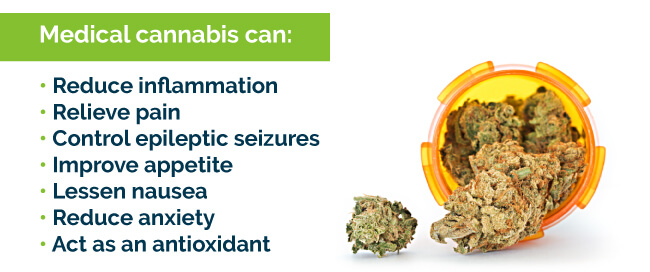
If your patient has a medical disorder that qualifies for medical marijuana use in their state, they will likely come to you asking about the benefits, risks and options of using it therapeutically for their specific ailment.
Obviously, you’ll want to educate yourself on local regulations and laws for recommending medical marijuana in your state before educating patients on medical marijuana.
Some patients aren’t good candidates for medical cannabis treatment. You’ll be able to determine this when you examine your patient and obtain their history. For instance, pregnant women may not be good candidates, or you may need to monitor them carefully. Schizophrenic patients would likely need close supervision of a psychiatrist.
Other reasons why you’d say no to medical cannabis include:
In 2013, around 7.5 percent of marijuana users were 12 years old or older, and there were 19.8 million current cannabis users. Around 17 percent of cannabis users who started using the drug during their teen years became dependent on it.
Teenagers are more likely to experience withdrawal-induced conditions than adults when discontinuing cannabis. Symptoms like aggression and restlessness could last more than a couple of weeks.
It’s essential your patients share the details of their marijuana use with you, including what kind they use, how they administer it and how frequently they use it. As you know, cannabis can have potential drug interactions with certain over-the-counter and prescription medications. By knowing the details of their use, you can make an informed decision about choices of medication and educate patients on marijuana contraindications or if you need to monitor them closely.
Cannabis has more than 60 cannabinoids, as well as more than 400 other types of chemicals, all carrying possible negative effects. You need to inform your patients of these side effects, as you would with any other medication.
Side effects of cannabis are typically mild, but do exist. Also, they usually occur more in novice users and recreational consumers. A few side effects may include:
Therefore, your best advice to your patient is to inform them to start on low doses of marijuana and increase doses gradually if needed.
The legalization of medical cannabis in certain states has provided patients a so-called weapon against pain and other debilitating symptoms. However, this doesn’t make it any easier for doctors. You’re likely uneasy about your role as a gatekeeper of a substance that’s federally controlled and has limited clinical research. You may be worried about legal liability or losing your license, even if you’re in a state that has approved cannabis for medicinal use. You’re not alone.
There are several things you need to look at before making any recommendations. For instance, each state’s rules differ, and as a doctor, you need to follow them as well to ensure you don’t lose your license or expose yourself to any civil penalties from an agency like the state health department.
However, your legal risk is minimal when it comes to certifying your patients for medical cannabis, mainly because you’re not dispensing the drug. You’re merely issuing your patients a written recommendation certifying that your patients are indeed suffering from a qualifying condition for medical cannabis as a treatment in their state. Your patients get the marijuana from a licensed cannabis supplier or dispensary, or may even grow it themselves in state-regulated quantities.
Some states ask for proof of residency from the patient, and most states require patients who are under 18 years old to have a parent or guardian accompany them. Unless you’re running a “pill mill” or are prescribing obscene amounts of narcotics inappropriately, nobody is going after you.
To convince a patient who’s not sure if they want to try medical cannabis, you can start by educating them about its wide array of benefits, including telling them about:
Currently, there are more than 60 health organizations in the United States and internationally that support giving patients immediate access legally to medical cannabis under a physician’s supervision.

Some of these organizations include:
These organizations also support the large-scale facilitation of clinical research trials to provide doctors with information so they can better assess the medical potential of marijuana.
Chances are you’ve heard the cannabis cliché “the munchies.” Despite this funny-sounding name, studies show your endocannabinoid system does help modulate appetite. Doctors treating eating disorders may find this particularly interesting. In fact, the International Journal of Eating Disorders published a study showing cannabinoids could also help treat anorexia.
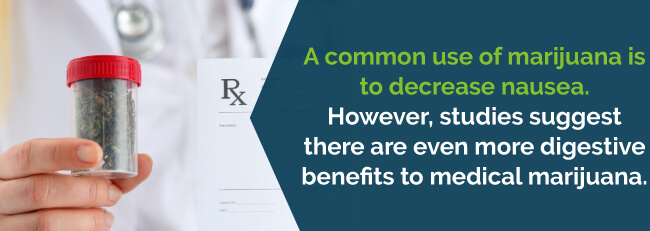
A common use of marijuana is to decrease nausea. However, studies suggest there are even more digestive benefits to medical marijuana. It may even play a role in various health conditions related to digestion, such as:
Cannabis has also been linked to good brain health. Cannabinoid receptor activity inside your brain before birth shows the compounds potentially benefit brain development. Marijuana may play a role in creating new brain neurons and overall brain plasticity.
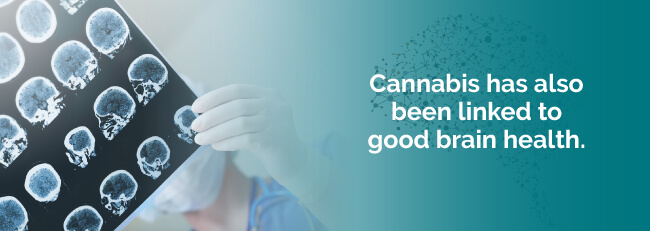
Additionally, medical marijuana may even have neuroprotective properties that could help in treating certain conditions such as:
Physicians can prescribe medical cannabis for chronic pain in states where it’s approved as a qualifying condition. The Spine Journal recently published a survey that found that at a Colorado spine center, one out of five patients were using marijuana to relieve their pain. Ninety percent of these patients claimed it relieved their pain moderately or greatly.
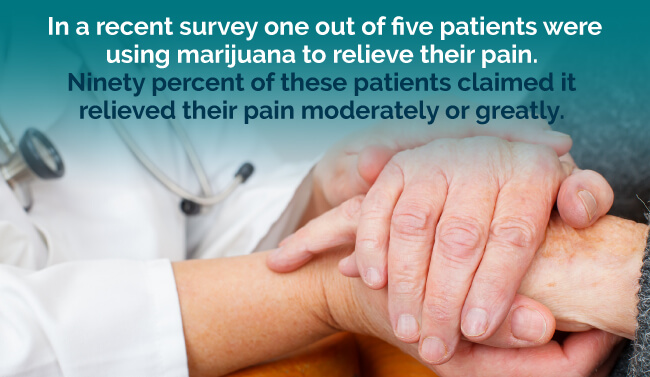
Because the above-referenced statistics were from a survey and not a clinical study, researchers need to study marijuana’s role in treating back pain. However, many people claim it helps their pain, and now science is finally catching up. For instance, a couple of types of pain that marijuana helps with include:
Having information like this at your disposal can make it a lot easier to bring up the subject of medical marijuana with your patients and persuading them to give it a try.
Other things to talk about include:
Scientific studies and research show medical cannabis can help battle many physical problems and diseases. It may help you through the debilitating symptoms of chemo and cancer, such as nausea and bone pain.
Cannabis can help regulate insulin production and assists your body in managing daily calorie intake better. This might be the reason most pot smokers are thinner than non-smokers. With our obese nation, this is probably great news for many people.
Medical cannabis kicks depression and anxiety out of the user’s mind. If your patient is skeptical about this, there was a 2010 Harvard Medical School study that showed marijuana’s biggest benefits occur because it improves the mood of the user and acts as a mild sedative.
Medical cannabis is much safer than tobacco, alcohol and harder substances. Studies reveal individuals find it simpler to use marijuana, rather than the other dangerous addictive medications. This is a significant health benefit, since marijuana can help save people from succumbing to hard drugs that can be lethal.
A study published in 2012 showed cannabis didn’t harm your lungs, but eliminated the negative impact caused by long-term cigarette smoking. More than 5,000 participants were in the study, and showed lung health deteriorated over time in tobacco smokers, while the marijuana smokers showed an increase in their lung capacity. Of course, patients who currently smoke cigarettes would have to quit to see any of these benefits.
Another 80 randomized trials where around 6,500 people took part shows support for medical marijuana use to treat certain conditions, including:
The Journal of the American Medical Association published these findings.
With marijuana legalized in certain U.S. states, it may be difficult to know what you should say to teenagers who are curious about the drug. This is understandable. For many patients, the time to experiment occurs during their teen years, and for doctors, these are the patients where confidential, practical and scientifically based advice is essential.
If you have already tried all other possible treatments and nothing seems to help, medical marijuana may be an option for your teen patient if you carefully monitor them.
Still, you need to know what to say. Doctors have to arm teen patients with correct information that will help them make informed decisions.
Things to tell your teen patient include:
Overall, doctors need to educate themselves about this changing environment. Cannabis is now a relatively new and potentially beneficial choice for patients. As a result, patients are embracing medical marijuana in increasing numbers. No matter the reason or cause of their treatment, as a doctor, you have to have an open dialogue with your patients. In most cases, you’re their mentor in their goal toward being healthy and receiving relief from their symptoms.
As you can see, a growing number of scientific studies confirm the many benefits medical cannabis has to offer. The ones presented here are just the tips of many icebergs. And, though there are possible side effects of marijuana, they’re minimal. Patients can minimize these side effects by vaping instead of smoking.
Whether or not medical marijuana should be legalized, it’s still a debated subject in the U.S., while other countries are already experiencing both medical and financial benefits of legalizing it.
Now that you know more about talking to your patients about medical marijuana, sign up to be listed on marijuanadoctors.com to connect with patients and join our newsletter for ongoing information tailored to
No Information on MarijuanaDoctors.Com should be used to diagnose, treat, prevent or cure any disease or condition. You can view our Full Disclaimer here.